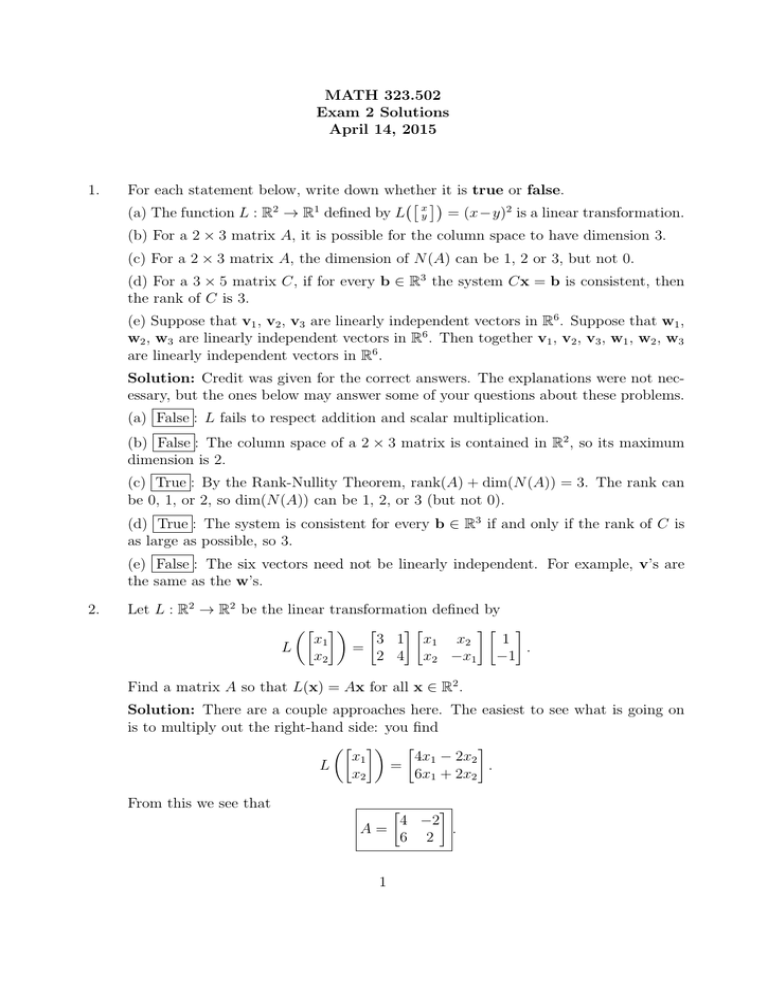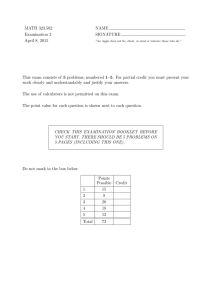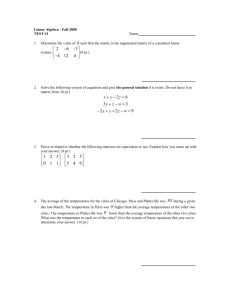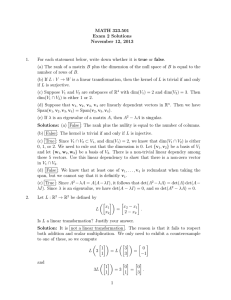MATH 323.502 Exam 2 Solutions April 14, 2015 1.
advertisement

MATH 323.502
Exam 2 Solutions
April 14, 2015
1.
For each statement below, write down whether it is true or false.
(a) The function L : R2 → R1 defined by L xy = (x−y)2 is a linear transformation.
(b) For a 2 × 3 matrix A, it is possible for the column space to have dimension 3.
(c) For a 2 × 3 matrix A, the dimension of N (A) can be 1, 2 or 3, but not 0.
(d) For a 3 × 5 matrix C, if for every b ∈ R3 the system Cx = b is consistent, then
the rank of C is 3.
(e) Suppose that v1 , v2 , v3 are linearly independent vectors in R6 . Suppose that w1 ,
w2 , w3 are linearly independent vectors in R6 . Then together v1 , v2 , v3 , w1 , w2 , w3
are linearly independent vectors in R6 .
Solution: Credit was given for the correct answers. The explanations were not necessary, but the ones below may answer some of your questions about these problems.
(a) False : L fails to respect addition and scalar multiplication.
(b) False : The column space of a 2 × 3 matrix is contained in R2 , so its maximum
dimension is 2.
(c) True : By the Rank-Nullity Theorem, rank(A) + dim(N (A)) = 3. The rank can
be 0, 1, or 2, so dim(N (A)) can be 1, 2, or 3 (but not 0).
(d) True : The system is consistent for every b ∈ R3 if and only if the rank of C is
as large as possible, so 3.
(e) False : The six vectors need not be linearly independent. For example, v’s are
the same as the w’s.
2.
Let L : R2 → R2 be the linear transformation defined by
x1
3 1 x1 x2
1
L
=
.
x2
2 4 x2 −x1 −1
Find a matrix A so that L(x) = Ax for all x ∈ R2 .
Solution: There are a couple approaches here. The easiest to see what is going on
is to multiply out the right-hand side: you find
x1
4x1 − 2x2
L
=
.
x2
6x1 + 2x2
From this we see that
4 −2
A=
.
6 2
1
3.
Let A be the matrix
1
0 1
6 0 ,
A= 3
−1 −6 2
let V be the column space of A, and let W be the row space of A.
(a) Find a basis for V . Show your work.
(b) Find a basis for W . Show your work.
(c) What is the rank of A? Explain.
(d) What is the dimension of the null space of A? Explain.
Solution: First we put A in reduced row echelon form:
1
0 1
1 0
1
1 0 1
3
6 0 −→ 0 6 −3 −→ 0 1 − 12 .
−1 −6 2
0 −6 3
0 0 0
(a) A basis for the column space of A is obtained by taking the columns from A
n 1 0 o
3
6
corresponding to the leading variables in the row echelon form of A:
, −6
.
−1
(b) A basis for the row space of A is the same as the non-zero rows of the row echelon
form of A: {(1, 0, 1), (0, 1, − 21 )} .
(c) The rank is the dimension of both the row space and the column space: 2 .
(d) The Rank-Nullity Theorem says that rank(A)+dim(N (A)) = 3, so dim(N (A)) = 1 .
4.
As usual we let S = {e1 , e2 } denote the standard basis for R2 . Suppose that B =
{u1 , u2 } is another basis for R2 , and suppose we have a change of basis matrix
4 7
B
P = [I]S =
.
1 2
That is, for every x ∈ R2 , we have [x]B = P [x]S .
(a) Find a matrix Q such that for every x ∈ R2 , [x]S = Q [x]B .
(b) What are u1 and u2 with respect to the standard coordinates on R2 ?
(c) Suppose that L : R2 → R2 is a linear transformation and that with respect to the
basis S we have [L]SS = ( 01 30 ). Find [L]BB .
Solution: (a) We see that Q = P −1 , so
2 −7
Q=
.
−1 4
(b) The standard coordinates of u1 and u2 are then the columns of Q:
2
u1 = ( −1
), u2 = ( −7
4 ) .
2
(c) Now [L]BB = [I]BS [L]SS [I]SB = P AQ, so
[L]BB
5.
2 −1
0 3
2 −7
4 7
.
=
=
1 −2
1 2
1 0
−1 3
Let S1 and S2 be finite subsets of a vector space V such that S1 ⊆ S2 . Let d1 be the
dimension of Span(S1 ), and let d2 be the dimension of Span(S2 ).
(a) Prove that d1 ≤ d2 .
(b) Prove that if Span(S1 ) = V , then d1 = d2 .
Solution: (a) Since S1 ⊆ S2 , every linear combination of vectors from S1 is also a
linear combination of vectors from S2 . Therefore,
Span(S1 ) ⊆ Span(S2 ).
Now as S1 spans Span(S1 ), it contains a basis {v1 , . . . , vd1 } of Span(S1 ) consisting of
d1 elements. This basis is also a linearly independent subset of Span(S2 ), so d1 is no
more than the dimension of Span(S2 ). That is, d1 ≤ d2 .
(b) If Span(S1 ) = V , then we have
V = Span(S1 ) ⊆ Span(S2 ) ⊆ V.
(The last containment occurs, since the span of a subset of a vector space is always
a subspace of that vector space.) Now since we have a chain of containments with V
on both ends, each containment must be an equality. Therefore,
V = Span(S1 ) = Span(S2 ) = V.
Since Span(S1 ) = Span(S2 ), we have d1 = d2 .
April 14, 2015
3






